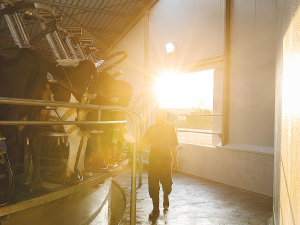Dairy sector profit still on the table, but margin gap tightens
DairyNZ’s latest Econ Tracker update shows most farms will still finish the season in a positive position, although the gap has narrowed compared with early season expectations.
 Detection of heat is often considered the major limiting factor in the success of reproductive programmes.
Detection of heat is often considered the major limiting factor in the success of reproductive programmes.
Increasing input costs on farm are topical, but it’s well-accepted that reproduction really is a key moment in the farming calendar.
Time, effort and money must be invested to set up future production. We all want to reduce cost where we can, yet we also want to hit the `sweet spot’ and capture the highest returns at the lowest effort and cost.
Coming straight out of calving there is so much on the plate. As pre-mating looms, farmers can be forgiven for not wanting to think too hard about reproduction or make any changes. But the time to think about this is right now, before you get your head down again.
Detection of heat is often considered the major limiting factor in the success of reproductive programmes. According to DairyNZ, every accurately detected heat can gain a farmer an average 25 kgMS, as well as avoiding late-calving which can impact the following season.
The primary sign of heat is where a cow stands to be mounted by another cow. This is the gold standard for heat detection. Secondary signs such as increased walking are those that can also be caused by events other than heat and are more loosely associated with the timing of ovulation. It is primary standing behaviour that is hard-linked to ovulation occurring around 25-32 hours from the onset of standing.
Decades of excellent studies have established the timing for when the farmer should submit the cow for breeding, because waiting for standing more than doubles the conception rate compared to a cow that is still coming into heat and is yet to stand. It is a common misconception with New Zealand farmers, that because sperm can survive 24 hours or more, breeding early doesn’t have an impact on conception rate. The effect is profound. Breeding too early can cost you 25 kgMS due to the lower chance of success and creates high odds you’ll have to wait for her next cycle.
The goal is to use tools that accurately call both the heat and the optimal timing for insemination to maximise success. The decision of whether to breed `today or tomorrow’ in a once-per-day insemination regime is critical. Getting this right can yield significant improvement in conception rates.
Farmers need to take the time to ask if an option they are evaluating truly addresses their real needs and if it does that job well. That means reviewing hard evidence and performance data that is specific and relevant to you, and not getting distracted with features that are not so important for your operation.
Being profit-based, return on costs must stack.
This means looking beyond what is simply cheapest if the performance of that option costs you lost production. Opportunity-cost in any given reproduction programme can be huge, so it really is worth asking hard questions and getting firm evidence for your chosen approach.
The range of heat detection approaches come with different cost and performance parameters to best fit your goals. Money needs to be spent wisely and you need to consider any `hassle-factors’ of change, the value of staff time and training requirements, technical support, resilience, and flexibility as well as any other upfront or ongoing costs to strike a balance for your system. We all want to put our money where the returns are greatest.
Add up your reproduction- related costs and divide that number by the total number of pregnancies, or perhaps even go a step further to look at the cost of reproduction per calf.
You can quickly model out where you think valuable gains can be made at little additional cost and effort in the first instance. This can help you find your `sweet spot’ for your operation and help focus on extra return that can be gained for little additional cost.
The National Wild Goat Hunting Competition has removed 33,418 wild goats over the past three years.
New Zealand needs a new healthcare model to address rising rates of obesity in rural communities, with the current system leaving many patients unable to access effective treatment or long-term support, warn GPs.
Southland farmers are being urged to put safety first, following a spike in tip offs about risky handling of wind-damaged trees
Third-generation Ashburton dairy farmers TJ and Mark Stewart are no strangers to adapting and evolving.
When American retail giant Cosco came to audit Open Country Dairy’s new butter plant at the Waharoa site and give the green light to supply their American stores, they allowed themselves a week for the exercise.
Fonterra chair Peter McBride says the divestment of Mainland Group is their last significant asset sale and signals the end of structural changes.
President Donald Trump’s decision to impose tariffs on imports into the US is doing good things for global trade, according…
Seen a giant cheese roll rolling along Southland’s roads?